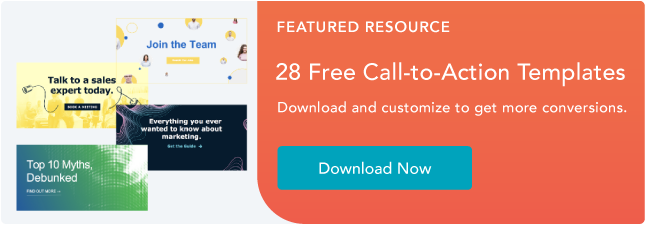Ever been on a first date, and right off the bat, they ask you about your plans for kids or your credit score?
That’s awkward.
Funnily enough, many brands are as intrusive — they bombard new visitors with a barrage of personal questions before they’ve even had the chance to browse. Before you know it, these visitors have bounced and have no plans of looking back.
Download Now: 28 Free CTA Templates
Progressive profiling is the suave counterpart to this approach. It’s a strategy that respects the customer’s space and pace. In this article, we’ll introduce you to progressive profiling, discuss why it’s great, and give you a few examples to get you started.
What is progressive profiling?
Progressive profiling is a method where you gradually collect customer data over multiple interactions, rather than asking for all information at once. You keep your forms short by queueing new questions so visitors see these questions gradually.
Progressive profiling solves a major problem for marketers, where you want to capture as much information as possible while maintaining the user experience. But how does it work exactly?
How Progressive Profiling Works
Instead of having one long form that attempts to capture all of a user’s information, you queue new questions for returning users so they see a different version of the form.
Initially, you ask for basic info — maybe just a name and email. The next time, you might request their job title or industry. Each click and each interaction peels another layer (like an onion) of your lead’s preferences and behaviors.
But it’s not just about demographics. You’re also tracking their journey — what they clicked on, what they liked, and what they didn’t like.
All of this information automatically syncs to the same contact record to create a full profile of your lead. Once they’re in your CRM as a “contact” or “subscriber,” first-party cookies track their behavior so you learn even more. And as you fill in these gaps, you tailor their experience.
Benefits of Using Progressive Profiling
Progressive profiling is a secret weapon in your marketing arsenal. It allows you to collect valuable customer data without overwhelming your audience. Here are some direct benefits of this approach:
Higher Conversion Rates
Progressive profiling leads to better conversion rates by tailoring interactions to each user. Collecting data gradually makes every interaction more relevant and engaging.
Conversion rates are important — our 2023 State of Marketing Report shows that 29% of marketers prioritize conversion rates as their top KPI. Why? Because it’s all about turning visitors into leads, leads into customers.
Suppose you sign up for a 30-day trial for Sprout Social. The sign-up page is pretty minimal (you don’t even need a credit card).

Once you sign up and log in, Sprout asks you for more details.

Questions about your company (name, size, country) are very relevant at this stage. It doesn’t feel like Sprout is bombarding you with unnecessary questions. An organic flow of information is much more likely to keep leads moving along the funnel.
Deeper Understanding of Leads
Progressive profiling gives you a chance to get to know your leads better by capturing their evolving interests and needs. You piece together your customer’s puzzle as each interaction adds a bit more to the complete picture.
When you know your customers well, you understand their pain points and what makes them click. And, McKinsey’s research shows companies that grow faster drive 40% more of their revenue from personalization than their slower-growing counterparts.
Sprout understands how important it is to know leads better. So, as soon as you jump into the free trial, they ask you what you’re planning on doing with the tool and what you’re hoping to achieve with it.

Again, these questions are very relevant. Plus, when you’re in the tool, Sprout tracks what you’re doing — pages visited, forms submitted, content downloaded. Each action tells a story, reveals a preference, and connects the dots.
Using these insights, Sprout can provide relevant content that helps you achieve your goals. The result? When you get content that speaks to you, you get more value out of the product and are more likely to act — sign up, buy, engage.
Better Data Quality
Progressive profiling leads to better data quality by gathering information bit by bit. It ensures accuracy because people are more likely to provide correct details in small doses. Data quality is the foundation for sales and marketing strategies. The better the data, the better the decisions.
Poor data quality is a big deal and costs organizations an average of $12.9 million. Imagine trying to hit a target blindfolded.
That’s what bad data does.
It leads to inaccurate targeting, missed opportunities, and a slow sales pipeline. Your team struggles to convert leads because they’re working with flawed information.
Think of progressive profiling as a filter. It builds a profile over time, and each interaction becomes a chance to check and refine. This way, you don’t just collect data. You curate it.
Enhanced Attribution
Marketing attribution allows marketers and sales teams to see the impact that marketing makes on a sale.
Did the blog on gardening tools lead to a spike in sales? Was it the email campaign about outdoor furniture that sealed the deal? This is where enhanced attribution comes into play, especially with progressive profiling.
With progressive profiling, you’re not just seeing isolated interactions; you’re seeing a connected journey. You track each step a customer takes, from reading a blog to downloading a guide. This provides a clearer picture of what influences your lead’s decisions.
This level of detail gives valuable data on when your lead made a purchase, plus how and why it happened.
When you have a clearer picture, map them out using a customer journey template to create a roadmap of your customer’s experience.
Get Started With HubSpot’s Customer Journey Map Template
It shows every touchpoint, and, with progressive profiling, you’re adding layers of information to this map for a more comprehensive view of what makes your leads click.
How to Use Progressive Profiling
Progressive profiling is all about timing your information requests and syncing these with your customer’s journey. Here’s how:
1. Use Dynamic CTAs/Webforms
Dynamic calls-to-action (CTAs) and web forms are like having a conversation that grows richer with each visit. You gather valuable information step-by-step to improve your understanding of your audience and maintain a smooth user experience.
Initially, your web form might ask for basic details like name and email. But next time, the form changes. It asks for different information, maybe a job title or a specific interest.
This approach engages your users. They’re not seeing the same old form every time. And for you? Each interaction is a chance to learn more and build a fuller picture of each customer.
Pro tip: Balance the questions. You don’t want to overwhelm your users with too many questions at once. Keep it simple and relevant. As they interact more, the form adapts and collects different pieces of information each time.
2. Use Personalization
Personalization makes each user feel unique and understood. You start with the basics, and as you gather more data, you personalize their experience through tailored content, targeted emails, or customized product recommendations.
At HubSpot, for example, suppose someone downloads our State of Marketing report. We follow up with this thank-you email and other relevant offers.

When the lead is interested in marketing reports, they’re more likely to be interested in marketing tools, too. Hence, the relevant recommendations. If someone checks out these tools, we know they’re nudging closer to a decision.
But it doesn’t stop there. In subsequent emails, we share more marketing resources the lead might find useful.

These emails are packed with templates, articles, case studies, and even an offer for a 14-day trial. We curate these emails based on interests and past interactions.
This targeted approach helps in two ways.
First, it keeps the lead engaged and interested. They’re not getting generic emails — they’re getting information they actually care about. Second, it moves them closer to a decision. With every resource, and every case study, they get a clearer picture of what you offer and how it benefits them.
3. Be Ethical
Ethical practices build trust between a company and its users. If users believe you’re keeping their data safe and using it responsibly, they’re more likely to engage and share information.
Of course, consumers want to see personalized recommendations and ads. But there’s also a fine line between being personal and just being plain creepy. Back in 2021, our survey highlighted which ads people consider the most invasive:

So, what do you do?
Start by being transparent. Let your users know what data you’re collecting and why. Provide clear privacy policies and obtain explicit consent. Here’s how we display a cookie banner on our website:

(Note: These banners are mandatory in certain regions like the E.U. and U.K.)
When personalizing, use data that users have willingly shared, rather than what you’ve gathered without their knowledge.
Also, give users control over their data. Empower them with preferences and opt-outs for certain data uses like in our form below:

This shows you not only respect their privacy but also value their right to control their own digital footprint.
Ethical profiling is about creating a positive, respectful relationship. It’s a long game, where trust translates into loyalty and word-of-mouth recommendations.
4. Create Relevant Content
Quality content is the cornerstone of lead nurturing. Every blog, research report, podcast, and webinar is an opportunity for you to pull leads in with authority and value. Learning what kind of content they interact with further builds lead profiles and helps you understand their interests.
But how do you create quality in the first place? Some tips:
- Examine customer service transcripts. These conversations shed light on what your customers struggle with. What frustrates them? What solutions are they seeking? Direct feedback inspires content that addresses these pain points head-on.
- Use social listening tools. What are the hot topics in your industry? What are people praising or complaining about? Social listening gives you a pulse on the conversation, so you can tailor your content to join in or even lead the discussion.
- Survey your audience. Don’t guess what they want — ask them. Use surveys to gather direct input on the types of content they find most helpful or topics they’re interested in.
- Analyze engagement data. Look at which content pieces have the highest engagement. Use this data to understand what resonates with your audience and do more of it.
5. Add Integrated Profiling and CRM Tools to Your Tech Stack
Integrated tools like HubSpot automate the data capture process across multiple touchpoints and update individual profiles in real time as new interactions occur. Queue up the next set of questions automatically with progressive profiling features (like this):
HubSpot captures every piece of content, form submission, and customer service interaction and uses this data to enrich lead profiles. A continuous loop of information feeds into your CRM, providing your sales and marketing teams with up-to-date, actionable insights.
With an integrated system, track and manage customer interactions across different channels, whether it’s through email, social media, or your website.
A holistic view enables you to create more targeted and personalized campaigns for improved customer engagement and higher conversion rates.
6. Implement Automated Lead Scoring
Lead scoring involves assigning numerical “points” to each lead you generate. You can score your leads based on their professional information and how they interact with your website and brand.
Lead scoring helps marketing and sales teams prioritize leads, respond to them appropriately, and convert those leads into customers.
Progressive profiling enriches your lead scoring system with fresh, relevant data. This way, the scoring system becomes more sophisticated to prioritize leads that are more engaged and likely to convert.
HubSpot’s predictive lead scoring software takes the full buyer experience into account, factoring in every interaction and touchpoint to assign scores. This comprehensive approach means that every download, click, and email open contribute to a lead’s score.
The result? A strategy that not only drives conversions but also builds a more efficient sales process.
Progressive Profiling Examples
You know why progressive profiling works well and what it can do for your marketing efforts. But how does it play out in the real world? Let’s dive into some concrete examples of progressive profiling in action.
Otter.ai: Pop-up Forms Post Login
Otter.ai uses progressive profiling through pop-up forms that appear after a user logs in. The first time you log in, the form is simple, requesting basic information like your name and email address.
As you continue to use the service, the forms evolve and ask for more specific details to improve your experience like this:

By understanding your department and role, Otter tailors its features to suit your needs better.
For example, if you’re in marketing, Otter might highlight resources that help with creating content from audio files. If you’re in HR, it could promote tools for transcribing interviews.
This progressive approach delivers content related to relevant features and improves the overall experience with the platform.
Sephora: Incentives to Complete Profiles
When new subscribers sign up, Sephora doesn’t overwhelm them with questions. Instead, they start with the basics, and then, as part of their loyalty program, they invite customers to provide more specific information like age, favorite brands, skin type, and hair concerns.

Sephora makes it worth the customer’s while. They promise personalized product recommendations in return. Customers are more likely to share their information because they know they’ll get something tailored just for them.
Customers enjoy a personalized shopping experience, and Sephora builds a rich, detailed customer database. It’s a win-win situation that fosters loyalty and encourages repeat business.
Flo: Gradual In-App Health Data Collection
Flo, the period and ovulation tracker, uses progressive profiling to deliver more accurate insights and personalized content.
When people first download Flo, it asks for the basics — the start date of their last period and average cycle length. As they continue to use the app, Flo starts to ask for more — day-to-day symptoms, mood fluctuations, and specific health concerns.

This gradual collection of information allows Flo to personalize user experiences. Based on the symptoms and data users log, the app provides insights into their cycle, predicts their next period with greater accuracy, and even offers health tips tailored to their reported symptoms.
The brilliance of Flo’s approach lies in its sensitivity to user comfort levels. By not asking for all information upfront, the app ensures users don’t feel overwhelmed.
Over time, as they build trust, users are typically more willing to provide additional information, knowing that it will be used to benefit their health and understanding of their own bodies.
Millennium Hotels: Reminder Emails to Complete Profiles
Emails remind new Millennium Hotels customers to complete their profiles. A series of strategically timed emails invites guests to provide additional details. These emails clearly communicate the benefits of providing such information: personalized experiences and special birthday treats.

Millennium incentivizes customers to share more information by offering loyalty points for each detail added to their profile. This could include preferences for room type, early check-in/late check-out, welcome amenities, or exclusive member prices.
This approach makes customers feel valued by promising tailored experiences and smartly gamifies the process of data collection.
Besides encouraging profile completion, the points system drives repeat business by increasing customer engagement with the loyalty program. Guests feel like they’re earning something back with every piece of information they provide, turning a mundane task into a rewarding experience.
Create a Well-Oiled Personalization Machine
Progressive profiling gets you the most bang for your marketing buck by ensuring that every interaction with a customer brings them a step closer to conversion and retention. This way, you don’t just anticipate customer needs but turn casual browsers into loyal advocates.
Plus, pairing it up with a CRM like HubSpot takes your personalization to the next level. Aligning progressive profiling with a solid CRM system creates a synergy that refines customer profiles with every interaction and makes that information immediately actionable.
Editor's note: This article was originally published in February 2013 and has been updated for comprehensiveness.
Forms












